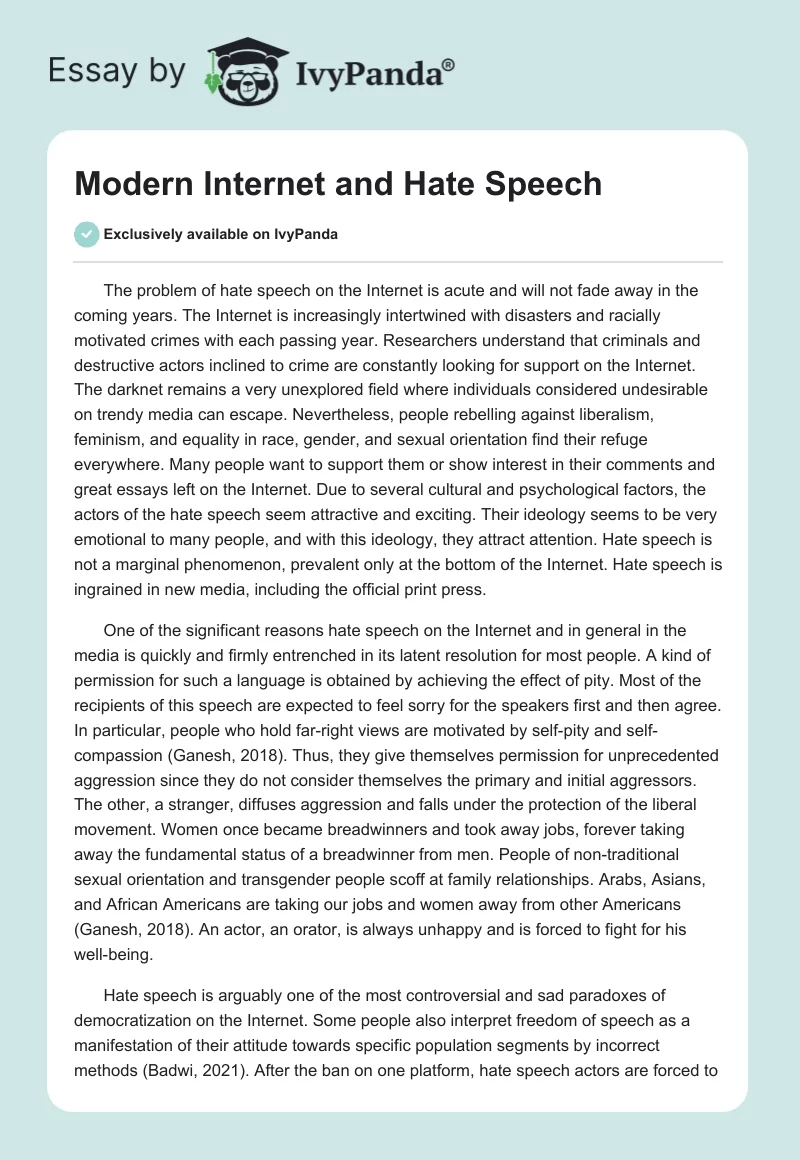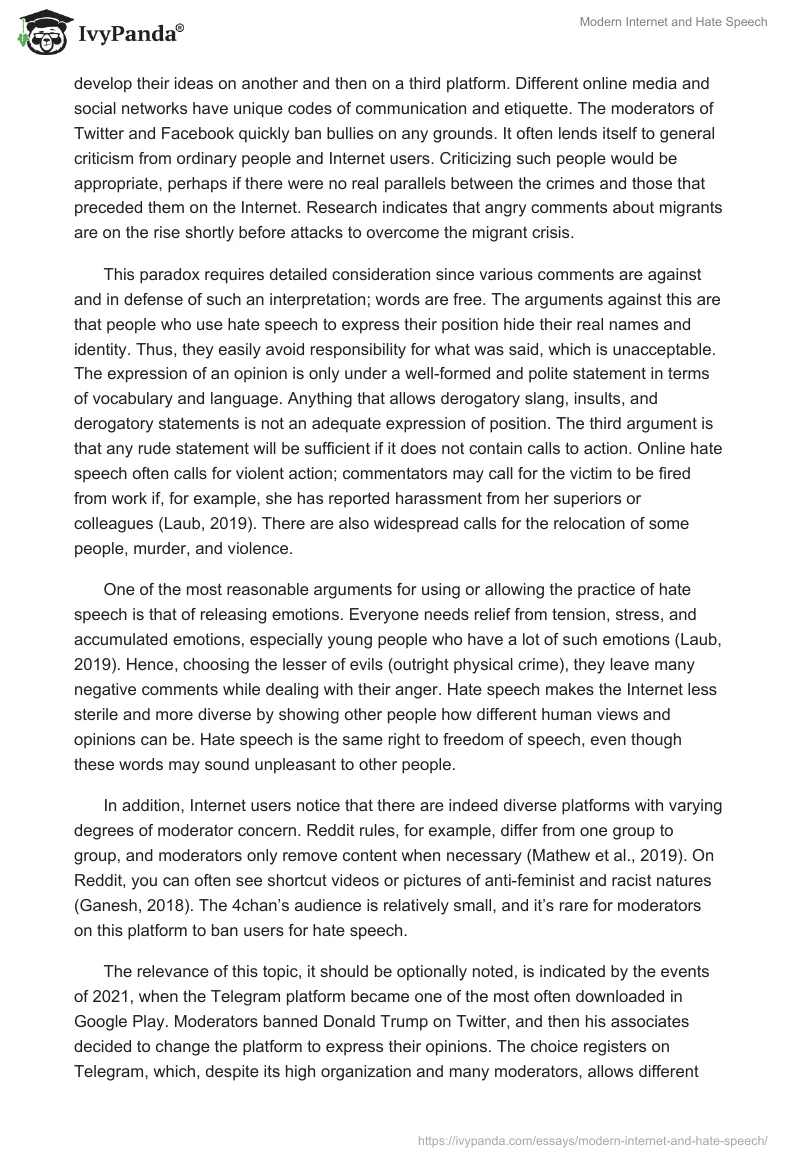The problem of hate speech on the Internet is acute and will not fade away in the coming years. The Internet is increasingly intertwined with disasters and racially motivated crimes with each passing year. Researchers understand that criminals and destructive actors inclined to crime are constantly looking for support on the Internet. The darknet remains a very unexplored field where individuals considered undesirable on trendy media can escape. Nevertheless, people rebelling against liberalism, feminism, and equality in race, gender, and sexual orientation find their refuge everywhere. Many people want to support them or show interest in their comments and great essays left on the Internet. Due to several cultural and psychological factors, the actors of the hate speech seem attractive and exciting. Their ideology seems to be very emotional to many people, and with this ideology, they attract attention. Hate speech is not a marginal phenomenon, prevalent only at the bottom of the Internet. Hate speech is ingrained in new media, including the official print press.
One of the significant reasons hate speech on the Internet and in general in the media is quickly and firmly entrenched in its latent resolution for most people. A kind of permission for such a language is obtained by achieving the effect of pity. Most of the recipients of this speech are expected to feel sorry for the speakers first and then agree. In particular, people who hold far-right views are motivated by self-pity and self-compassion (Ganesh, 2018). Thus, they give themselves permission for unprecedented aggression since they do not consider themselves the primary and initial aggressors. The other, a stranger, diffuses aggression and falls under the protection of the liberal movement. Women once became breadwinners and took away jobs, forever taking away the fundamental status of a breadwinner from men. People of non-traditional sexual orientation and transgender people scoff at family relationships. Arabs, Asians, and African Americans are taking our jobs and women away from other Americans (Ganesh, 2018). An actor, an orator, is always unhappy and is forced to fight for his well-being.
Hate speech is arguably one of the most controversial and sad paradoxes of democratization on the Internet. Some people also interpret freedom of speech as a manifestation of their attitude towards specific population segments by incorrect methods (Badwi, 2021). After the ban on one platform, hate speech actors are forced to develop their ideas on another and then on a third platform. Different online media and social networks have unique codes of communication and etiquette. The moderators of Twitter and Facebook quickly ban bullies on any grounds. It often lends itself to general criticism from ordinary people and Internet users. Criticizing such people would be appropriate, perhaps if there were no real parallels between the crimes and those that preceded them on the Internet. Research indicates that angry comments about migrants are on the rise shortly before attacks to overcome the migrant crisis.
This paradox requires detailed consideration since various comments are against and in defense of such an interpretation; words are free. The arguments against this are that people who use hate speech to express their position hide their real names and identity. Thus, they easily avoid responsibility for what was said, which is unacceptable. The expression of an opinion is only under a well-formed and polite statement in terms of vocabulary and language. Anything that allows derogatory slang, insults, and derogatory statements is not an adequate expression of position. The third argument is that any rude statement will be sufficient if it does not contain calls to action. Online hate speech often calls for violent action; commentators may call for the victim to be fired from work if, for example, she has reported harassment from her superiors or colleagues (Laub, 2019). There are also widespread calls for the relocation of some people, murder, and violence.
One of the most reasonable arguments for using or allowing the practice of hate speech is that of releasing emotions. Everyone needs relief from tension, stress, and accumulated emotions, especially young people who have a lot of such emotions (Laub, 2019). Hence, choosing the lesser of evils (outright physical crime), they leave many negative comments while dealing with their anger. Hate speech makes the Internet less sterile and more diverse by showing other people how different human views and opinions can be. Hate speech is the same right to freedom of speech, even though these words may sound unpleasant to other people.
In addition, Internet users notice that there are indeed diverse platforms with varying degrees of moderator concern. Reddit rules, for example, differ from one group to group, and moderators only remove content when necessary (Mathew et al., 2019). On Reddit, you can often see shortcut videos or pictures of anti-feminist and racist natures (Ganesh, 2018). The 4chan’s audience is relatively small, and it’s rare for moderators on this platform to ban users for hate speech.
The relevance of this topic, it should be optionally noted, is indicated by the events of 2021, when the Telegram platform became one of the most often downloaded in Google Play. Moderators banned Donald Trump on Twitter, and then his associates decided to change the platform to express their opinions. The choice registers on Telegram, which, despite its high organization and many moderators, allows different content to exist and be distributed. People in the future may be seriously concerned about the problem of anonymity on the Internet. They will prefer platforms like Telegram for the sense of security they provide, as well as some lack of censorship and variety of content.
The topic of hate speech overlaps with the complex issue of online bullying, which often affects micro-societies such as classrooms, university groups, or groups of friends. It is also a vital and challenging topic that implicitly affects our society and the use of the Internet (Badwi, 2021). Bullying victims face a hostile Internet space and often do not know where to look for support. This topic requires a lot of independent research and discussion of specific examples.
In conclusion, for many, hate speech seems attractive, even on a subconscious level, because it contains self-pity and self-salvation. Aggressors call themselves protectors, while their victims are called aggressors. On a psychological level, defenders are perceived with a sense of pride and respect. It is the main reason why most people tolerate hate speech. The topic of hate speech was generated by the democratization of the Internet and has become its central paradox, requiring the discussion of different views. Arguments against hate speech include anonymity and avoidance of responsibility, offensive slang, and incitement to violence. Arguments for hate speech as an acceptable option for communication on the Internet refer to freedom from emotions, diversity, and, obviously, the fundamental freedom of speech.
Different platforms use different tools to combat hate speech and have different tolerance levels. 4chan and the Telegram platform, which has become very popular and downloadable, are incredibly tolerant platforms where actors who have received a ban on Twitter or Facebook seek shelter. The topic of hate speech affects the cultural, social, political, and psychological aspects; therefore, along with the complex problem of bullying on the Internet, it requires a very detailed study in the future. In the years to come, it will become more relevant as the Internet includes more and more users.
Reference List
Badwi, E. (2021) Digital hate speech. Web.
Ganesh, B. (2018) ‘The ungovernability of digital hate culture,’ Journal of International Affairs 71(2): 30–49.
Laub, Z. (2019) Hate speech on social media: global comparisons. Web.
Mathew, B. et al. (2019) ‘Thou shalt not hate: countering online hate speech,’ Proceedings of The International AAAI Conference on Web and Social Media, 13: pp. 369-380.


